There are nine different types of speed limit signs you’ll see on the UK’s roads, excluding historic and special signs. Some of them are prescriptive (i.e. must be obeyed), while some are suggested speeds.
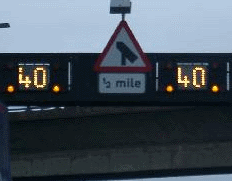
This gantry sits over a dual carriageway. When the weather conditions are adverse, the variable signs can be used to display a suggested speed, with flashing amber lights drawing a motorist’s attention to the speed.

This sign indicates a suggested maximum speed and is often seen underneath a sign showing a bend in the road. If the weather is bad (e.g. raining or icy), then vehicles should look to reduce their speed underneath this suggested limit. Note that the suggested speed will not be relevant to all vehicles.
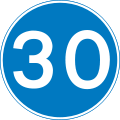
There are times when a minimum speed is required, such as in some tunnels. These blue signs with white writing indicate that vehicles must maintain at least a minimum speed (in this case 30mph).
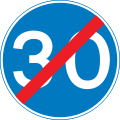
Once a minimum speed limit has ended, then a blue sign with the limit and a red line through it will be shown. The speed limit will then become either what is signposted, or that of the prevailing type of road, for example, the open road speed limit.
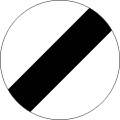
This sign indicates that the national open road speed limit applies, which is 60mph on a single carriageway or 70mph on a dual carriageway or motorway. It doesn’t necessarily mean that the road is safe to do 60mph or 70mph all the time – there may be sharp bends and other challenging sections, especially on a single carriageway road.

At roadworks, you might see a temporary speed limit sign, such as this 30mph one. It’s there to help protect road worker from flying debris, to minimise the chance of injury in case one is hit, and also to protect your vehicle as the road surface might be rough.
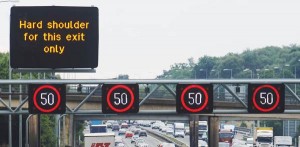
Gantries across motorways can advise of temporary speed limits and where a hard shoulder is open (smart motorways). These speed limits must be obeyed and can be controlled centrally to take into account other factors such as traffic volumes, weather, accidents, etc.
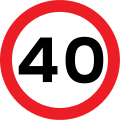
The basic speed limit sign, which has been around for decades, is a red circle with a black number contained within it. The limits almost always end in zero – you may see private road signs stating 5mph.

Some local councils have experimented with lower speed zones around schools. In the case of this sign, it’s active when the lights flash.
Speed limits may be enforced by the police and local authorities using a mixture of methods such as traffic cameras, traffic calming measures (road humps), and policing.
There are areas of the world where there are no speed limits such as some rural roads on the Isle of Man, and some Autobahns. However, most countries impose speed limits on all their roads usually ranging from 20mph to 85mph. Even where the enforcement of speed limits is both impractical and unlikely, such as in the Australian outback, they still apply.
Speed limits are a useful tool in maintaining road safety. Most new drivers are thoroughly taught about speed limits, not only to help them pass an easy online traffic school course or get their license quickly, but to keep them and other drivers safer on the road.
The basic laws of physics say that the faster you go, the more likely you are to be injured – the speed itself isn’t the killer, it’s more the instant and abrupt stop, or the g-forces associated with any change in speed or direction due to a crash. Speed limits are also controversial, especially if enforcement is overly strict, or where the general public is at mass disagreement with an artificially low or high limit.
